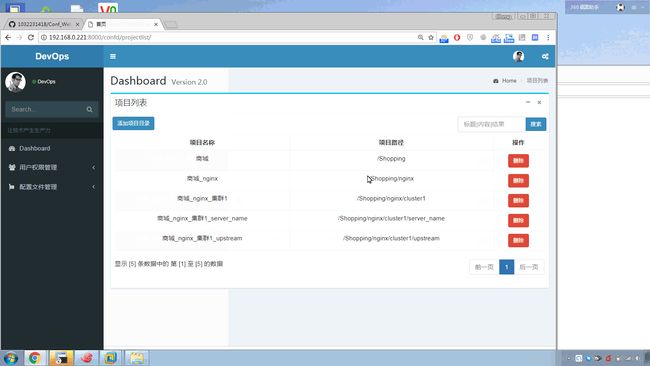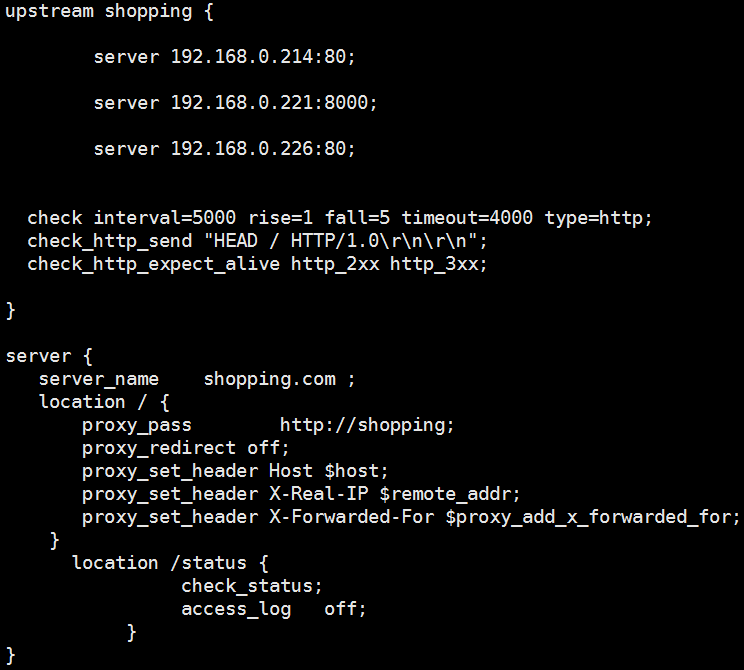Nginx配置管理平台
软件环境
centos7 python2.7.6 etcd3.2.18 confd 0.16 nginx1.12.1
效果演示
拓扑图
涉及软件
软件部署
1)安装 etcd(这里安装的单机,集群环境根据自己的需求选取)
# yum install etcd -y
# sed -i 's/localhost/0.0.0.0/g' /etc/etcd/etcd.conf #配置监听地址
# systemctl start etcd && systemctl enable etcd #启动服务设置开机动2)安装 nginx
#yum install python-devel gcc gcc-c++ pcre pcre-devel patch unzip zlib zlib-devel openssl openssl-devel git -y #依赖包
#cd /usr/local/src
#wget http://nginx.org/download/nginx-1.12.1.tar.gz
#git clone https://github.com/yaoweibin/nginx_upstream_check_module.git
#tar -zxvf nginx-1.12.1.tar.gz
#cd nginx-1.12.1
#patch -p1 3)安装 confd
下载地址https://github.com/kelseyhightower/confd/releases
下载完毕丢到系统里面
# cp confd /usr/bin/confd
# which confd
/usr/bin/confd4)创建配置文件目录
# mkdir -p /etc/confd/{conf.d,templates}
conf.d # 资源模板,下面文件必须以toml后缀
templates # 配置文件模板,下面文件必须以tmpl后缀5)创建 confd 配置文件
# vi /etc/confd/conf.d/app01.conf.toml
[template]
src = "app01.conf.tmpl" #默认在/etc/confd/templates目录下
dest = "/usr/local/nginx/conf/vhost/app01.conf" #要更新的配置文件
keys = [
"/Shopping", #监测的key
]
reload_cmd ="/usr/local/nginx/sbin/nginx -s reload" #最后执行的命令6)创建 confd 模板
# vi /etc/confd/templates/app01.conf.tmpl
upstream {{getv "/Shopping/nginx/cluster1/proxy_name"}} {
{{range getvs "/Shopping/nginx/cluster1/upstream/*"}}
server {{.}};
{{end}}
check interval=5000 rise=1 fall=5 timeout=4000 type=http;
check_http_send "HEAD / HTTP/1.0\r\n\r\n";
check_http_expect_alive http_2xx http_3xx;
}
server {
server_name {{range getvs "/Shopping/nginx/cluster1/server_name/*"}} {{.}} {{end}};
location / {
proxy_pass http://{{getv "/Shopping/nginx/cluster1/proxy_name"}};
proxy_redirect off;
proxy_set_header Host $host;
proxy_set_header X-Real-IP $remote_addr;
proxy_set_header X-Forwarded-For $proxy_add_x_forwarded_for;
}
location /status {
check_status;
access_log off;
}
}7)启动 confd 并设置开机启动
开机启动脚本会给大家分享
拷贝至 /etc/init.d/confd ,只需要更改 etcd 的连接地址即可
#/etc/init.d/confd start && chkconfig --add confd && chkconfig confd on配置平台部署
1)Github 克隆平台代码安装平台依赖
# git clone https://github.com/1032231418/Conf_Web.git
# cd Conf_Web/ospweb/
#yum install python-pip -y #安装pip
#mkdir /root/.pip/ #创建pip源配置文件目录
# vi /root/.pip/pip.conf #修改为阿里云的pip源
[global]
trusted-host=mirrors.aliyun.com
index-url=http://mirrors.aliyun.com/pypi/simple/
[list]
format=columns
#pip install virtualenv #安装沙盒工具
#virtualenv env #建议创建一个沙盒环境跑该平台
# source env/bin/activate #使用沙盒环境
# pip install -r requirement.txt #安装相关软件2)创建数据库并将表刷入数据库
# mysql -p #登录数据库为平台创建一个数据库
#CREATE DATABASE opsweb CHARACTER SET utf8 COLLATE utf8_general_ci; #创建数据库opsweb
# vi opsweb/settings.py #这里数据库信息改为自己的数据库信息
DATABASES = {
'default': {
'ENGINE': 'django.db.backends.mysql',
'NAME': 'opsweb',
'HOST': 'localhost',
'USER': 'root',
'PASSWORD': '123456',
'PORT': 3306,
}
}
ETCD_Server = "192.168.0.221" #这里改为自己etcd 的ip地址
ETCD_Port = 2379
# python manage.py migrate #提交迁移文件至数据库,将表刷入数据库3)创建超级管理员账号
# python manage.py createsuperuser4)运行平台
# python manage.py runserver 0:8000
访问地址就是 http://ip:8000 账号密码就是上一步创建的超级管理员账号密码5)登录平台为 nginx 创建 key/value
例子: Shopping 平台为例
项目创建
1.创建商城项目 /Shopping
2.创建商城项目里面的 /Shopping/nginx nginx 服务
3.创建nginx 集群目录 /Shopping/nginx/cluster1
4.给我们的商城 nginx 集群1项目创建配置文件
5.域名 和 节点名称可能是多个,这里我们需要创建目录 /Shopping/nginx/cluster1/server_name 和 /Shopping/nginx/cluster1/upstream
etcd 里面存储的值
配置创建:
1.反向代理 /Shopping/nginx/cluster1/proxy_name
2.绑定一个域名 /Shopping/nginx/cluster1/server_name/1
3.创建一个集群节点 /Shopping/nginx/cluster1/upstream/web1
etcd 里面存储的值
生成的配置文件
通过hosts 文件我们可以查看节点状态(虽然这个节点不是up 状态但是由此可见,我们可以动态添加节点)
五.nginx + uwsgi + django 项目部署
1)uwsgi 部署
#source env/bin/activate #使用沙盒
#pip install uwsgi #安装 uwsgi
#vi uwsgi.ini
[uwsgi]
# 配置服务器的监听ip和端口,让uWSGI作为nginx的支持服务器的话,设置socke就行;如果要让uWSGI作为单独的web-server,用http
http = 127.0.0.1:8000
#socket = 127.0.0.1:3309
# 配置项目目录(此处设置为项目的根目录)
chdir = /home/web/opsweb
# 配置入口模块 (django的入口函数的模块,即setting同级目录下的wsgi.py)
wsgi-file = opsweb/wsgi.py
# 开启master, 将会多开一个管理进程, 管理其他服务进程
master = True
# 服务器开启的进程数量
processes = 8
# 以守护进程方式提供服, 输出信息将会打印到log中
daemonize = wsgi.log
# 服务器进程开启的线程数量
threads = 4
# 退出的时候清空环境变量
vacuum = true
# 进程pid
pidfile = uwsgi.pid
# 配uWSGI搜索静态文件目录(及django项目下我们存放static文件的目录,用uWSGI作为单独服务器时才需要设置,此时我们是用nginx处理静态文件)
# check-static = /home/web/opsweb/static/
#/home/env/bin/uwsgi --ini uwsgi.ini #启动服务
2)nginx 反向代理配置
#vi /usr/local/nginx/conf/vhost/ops.conf
upstream ops_web {
server 127.0.0.1:8000;
}
server {
server_name ops.xxx.com; #改为你平台的域名
location / {
proxy_pass http://ops_web;
proxy_redirect off;
proxy_set_header Host $host;
proxy_set_header X-Real-IP $remote_addr;
proxy_set_header X-Forwarded-For $proxy_add_x_forwarded_for;
}
location /static {
alias /home/web/opsweb/static/;
}
}
#/usr/local/nginx/sbin/nginx -s reload #重新加载配置文件
参考
https://github.com/fungitive/Conf_Web
https://github.com/Qihoo360/QConf/blob/master/README_ZH.md








